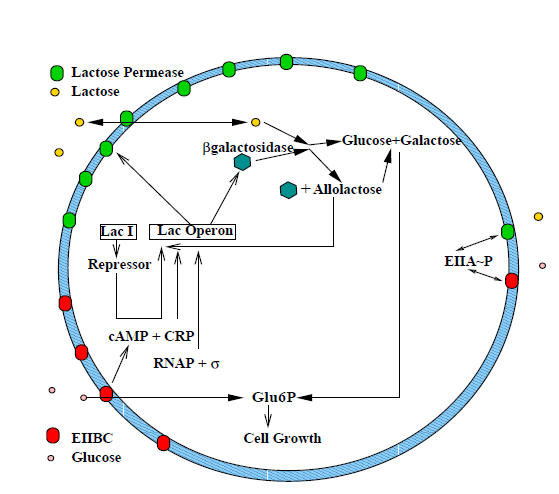Team:Imperial College London/Drylab/Autoinduction/Model3
From 2009.igem.org

- Overview
- Kompala et al model
- Kompala et al simulations
- Keasling et al model
- Kremling
Model Rationale
Several models have focused on inducing the lac operon using IPTG[1 (ref fro protein prod)] but not many have focused on induction by lactose.
The Keasling model in the system describes diauxic growth under the presence of glucose and lactose, and includes the different stages of metabolism of both sources. Here are the main points to remember:
- The lac operon is controlled by glucose at 2 levels: Inducer exclusion and catabolite repression.
- Inducer exclusion: Relates to the constitutive expression of LacI repressor protein (see protein production pages for more on this), originally repressing the Lac operon.
- Catabolite repression: Repression of cAMP by high levels of glucose present in the medium at the start of the culture, also preventing transcription of the lac operon.
- When glucose runs out, the lac operon is induced.
- When lactose is transported into the cell (by lac permease) and hydrolised into smaller chain length carbon sources by b-galactosidase.
- Glucose-6-phosphate amounts control the rate of growth of the cell culture.
Model Assumptions
- All binding interactions (RNA polymerase-promoter, CRP-cAMP binding site, repressor-allolactose-operator) are 1:1
- E.g. 1 molecule of cAMP binds to 1 CRP
- The 3 binding interactions mentioned are the only factors contributing to transcription efficiency of the lac promoter, neglecting other possible entities.
- Also, since b-galactosidase is a tetramer, the rate constant of b-galactosidase was assumed to be 1/2 the rate for synthesis of the permease to account for differences in productivity.
- Degradation and dilution due to cell growth of LacZYA mRNA, b-galactosidase and permease were assumed to be first order.
- Efficiency of translation was assumed to affect the mRNA degradation rate, effects which were not included in the model.
Model predictions
- In this model two hypotheses for catabolite repression are tested:
- Catabolite repression is dependent on extracellular glucose concentrations.
- Catabolite repression is dependent on the rate of transport of glucose into the cell.
- The question posed from the two possible catabolite repression pathways is: Will one or the other have a significant effect on the outcome of the model?
- Furthermore, two hypotheses for the phosphorilation of glucose produced from lactose hydrolysis were tested:
- Phosphorilation by intracellular hexokinase
- Secretion of glucose and phosphorilation once it is transported back into the cell.
The second hypotheses would be predicted to add to the effect of catabolite repression.
- Parameter sensitivity predictions:
- Lactose and alollactose transformation rates by b-galactosidase enzyme and large glucose concentrations will affect the extent of repression by indurcer exclusion.
- Large values in allolactose hydrolysis rate will result in low concentrations of allolactose.
- Changes in b-galactosidase reaction rates will have more effects on growth rate.
- Changes in the glucose concentration that inhibited lactose transport could extend or contract the diauxic growth period during growth in the presence of glucose and lactose.
- Changes in glucose concentration affected catabolite repression and cAMP levels, may have less of an effect on growth rate than the previous case.
 "
"




